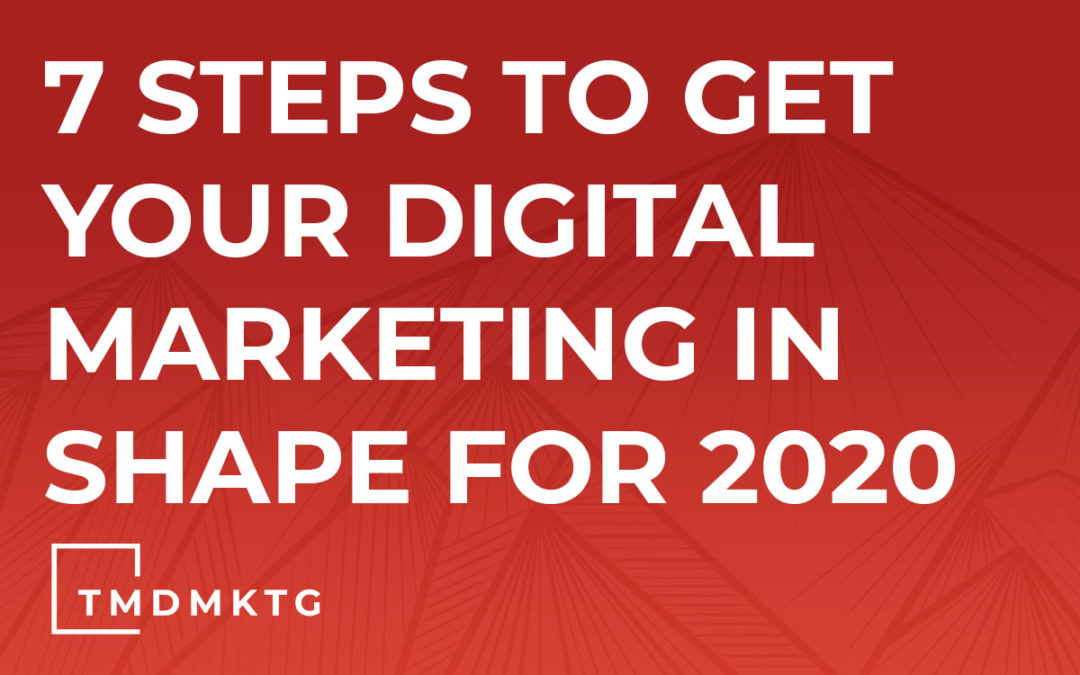With a new year upon us, there’s a good chance you are making a list of resolutions. Eat better, spend more time with your kids, prioritize fitness, take up a new hobby, etc. All fantastic goals, but don’t forget your business marketing. Now is an ideal time to evaluate where it stands and where you’d like to take it.
Every business should give their SEO, lead generation, content strategy and other marketing efforts an annual health check. It’s an opportunity to pause, contemplate successes and failures, and to refocus on the challenges ahead.
Below is our 7-step action plan to help launch your online marketing to new heights for 2020 and beyond.
1. Lead Generation
The primary objective of having a website is to promote your business. However, what’s just as critical, if perhaps not more so, is gaining traffic and converting it to leads.
After you determine the amount of traffic your website produces and the number of leads you convert, it’s necessary to see what action you can take to enhance these numbers.
Various components you can adjust include:
- Is your content sufficiently relevant and do you harness it to convert leads?
- Value proposition. Does it clearly articulate why prospects should convert? Are the benefits made crystal clear? Does it distinguish you from your competition?
- Calls to action. Are they direct and located above the fold? Is your copy captivating and persuasive?
- User experience. Is your website simple to browse? Can your users easily identify what they’re searching for?
If your conversion rate is down, some of these elements might be to blame.
2. Content Strategy
Content is the foundation of every effective marketing strategy. Simply put, if you neglect to offer superior content, you’ll be in a bind regardless of how incredible your product or service is.
Besides being instructive, and enjoyable to read, your content must also be cohesive– you can’t publish a blog post and then wait three weeks to post the next one. That’s a foolproof way of alienating your audience.
The amount of content you release is also vital. Studies suggest that websites that publish in excess of 16 blog posts per month score nearly 3.5 times more leads than those with fewer than four.
It’s important to stress that content doesn’t only pertain to the blog posts you publish. You need to have content types appropriate for each phase of the buyer’s journey. White papers, how-to guides, customer studies, and instructive videos should help your prospects grasp whether your product is an ideal fit, in addition to how to use it for optimal results.
Your product or service pages are also key pieces of your content marketing strategy, so ensure your descriptions are detailed, benefit-focused and captivating. Don’t insist on your products’ features and specs – describe precisely how they can address your prospects’ challenges.
3. SEO Strategy
All the content stated above won’t be effective without an adequate SEO and link building strategy which will boost your search engine rankings and put you directly in front of the appropriate people’s eyes.
Conduct an audit to determine whether there are applicable keywords within your –
- Meta titles
- Meta descriptions
- Content
- Image alt text.
In addition to this, you should strengthen your internal link structure by incorporating links to numerous related posts within your content. Be sure to identify whether there are any broken links lurking on the website and correct them.
Backlinking is another significant aspect of your SEO strategy that requires a thorough examination. Specifically, building links can considerably advance the online reputation of your business, but only if these links to your website originate from trustworthy sources.
Consequently, you need to audit your backlinks and determine whether any dubious websites link back to your content.
4. Nurturing Strategies
There’s a critical step between developing leads and converting them, and that’s nurturing.
This process guarantees that your prospects receive all the information about your products and services at the right time.
Nurturing can be carried out in various ways, including videos, email campaigns, engaging content that helps your prospects solve some of their challenges and other measures that will entice your leads and interest them.
Customizing your content predicated on the various segments of your audience is another pivotal factor of successful nurturing.
Finally, having all the necessary customer information is a must, and that’s what marketing – sales and marketing alignment – is all about. Be sure to review how these two departments collaborate, as insufficient communication between them prohibits qualifying good leads and impedes successful nurturing. So, sharing intel and data between these two teams should be among your highest priorities when it comes to fortifying your marketing strategy.
5. Social Media
It’s no secret just how important social media is to enhance brand awareness, produce more leads, and in the end, generate more conversions. A recent study concluded 45 percent of the globe is on social media. If your mission is to connect with the greatest amount of people, your business must leverage social media, as well.
While there are many potential social media platforms on the market, the following are a few of our favorites.
2.4 billion people use Facebook every month to connect with friends and family and to discover things that matter.
People come to Instagram to express themselves, be inspired and take action. Businesses use Instagram to show their brand personality, find customers and promote products and services to an engaged audience.
6. Messaging
Your value proposition is your trump card – the secret sauce that grabs the attention of your customers and conveys to them exactly why they have to select your business instead of your competition.
It explains how your prospects will benefit from using your product and what pain points it addresses.
This audit should let you know how effective your value proposition is in persuading your leads to convert.
Your messaging, as a whole, should take this value proposition into account and be consistent in regards to it.
7. Website Technical Performance
Once more, your leads won’t have a chance to view all your great content, discover more about your products, and interact with your business if your website isn’t speedy. They will simply abandon your site while they’re waiting for it to load.
So, it’s imperative that you test and assess the technical performance of your website.
Monitor website design, mobile responsiveness, loading speeds, error messages, and anything else that could potentially frustrate your visitors and make them leave.
After you gather all the data from your research and identify all the underachieving areas of your marketing measures, it will be much simpler to change and optimize your marketing strategy to make it more successful.
Want to talk about how TMD Marketing & Advertising can help your business achieve its objectives online? Let’s connect


Recent Comments